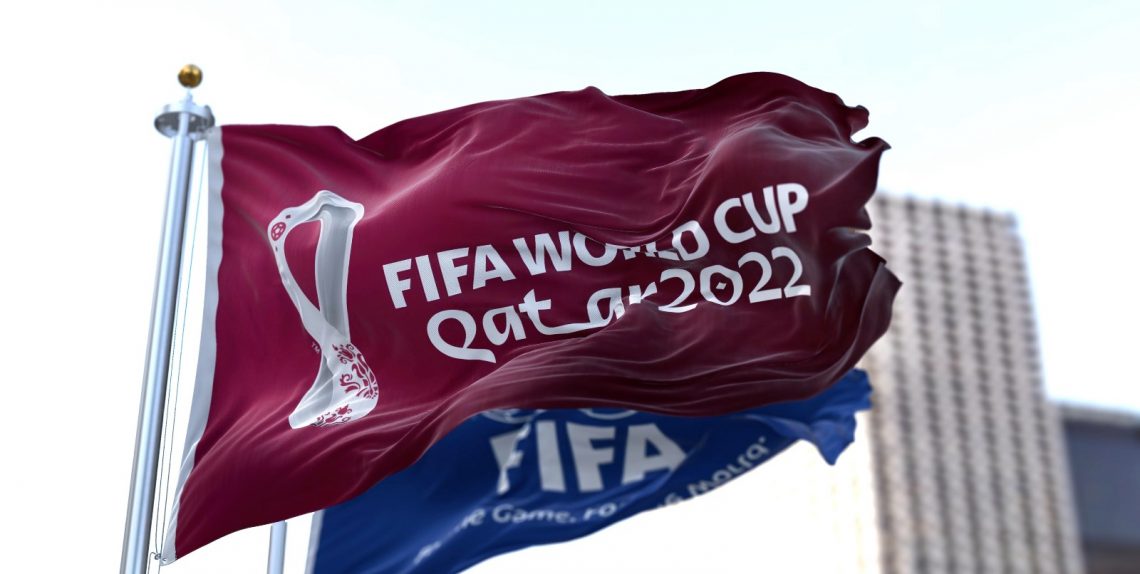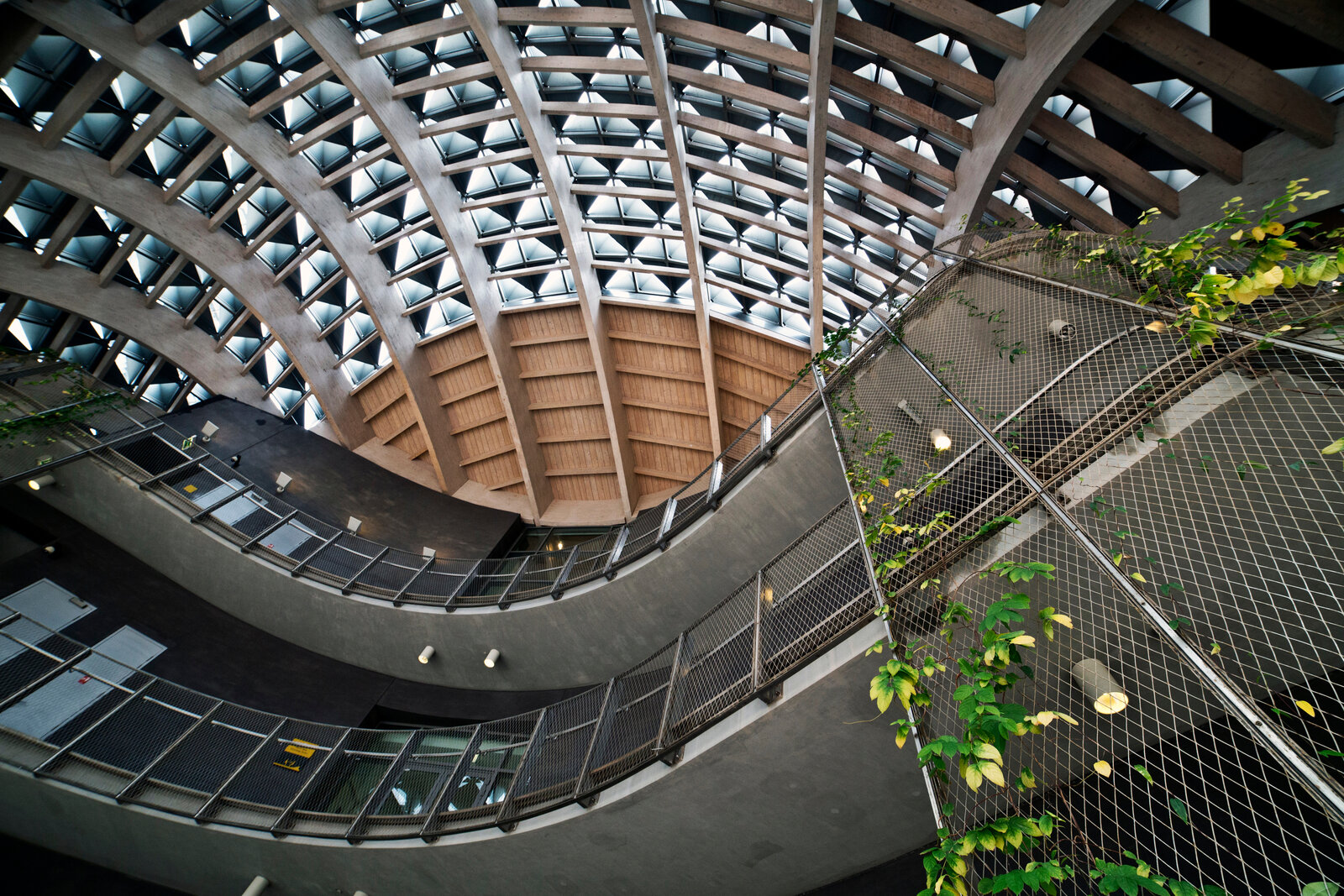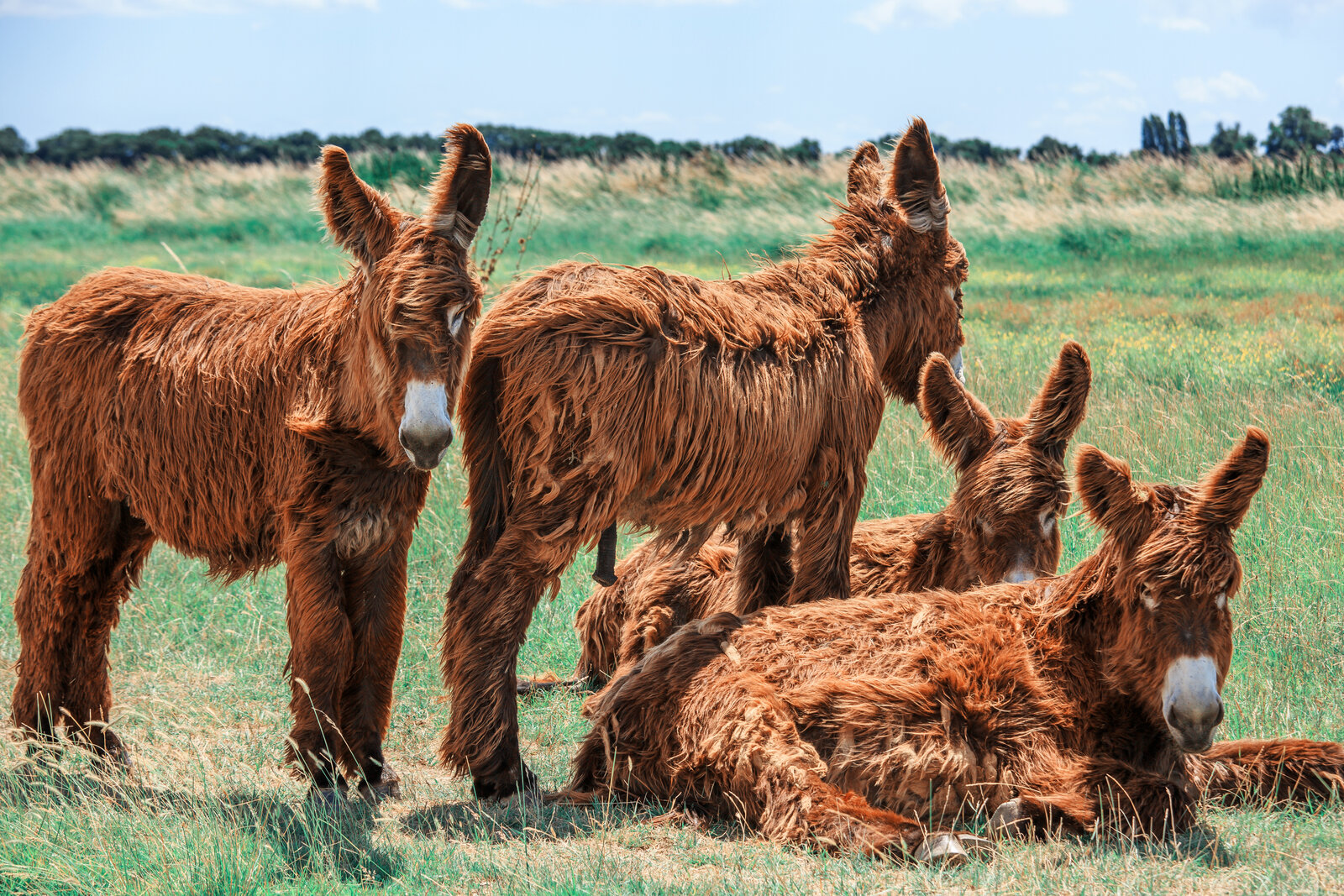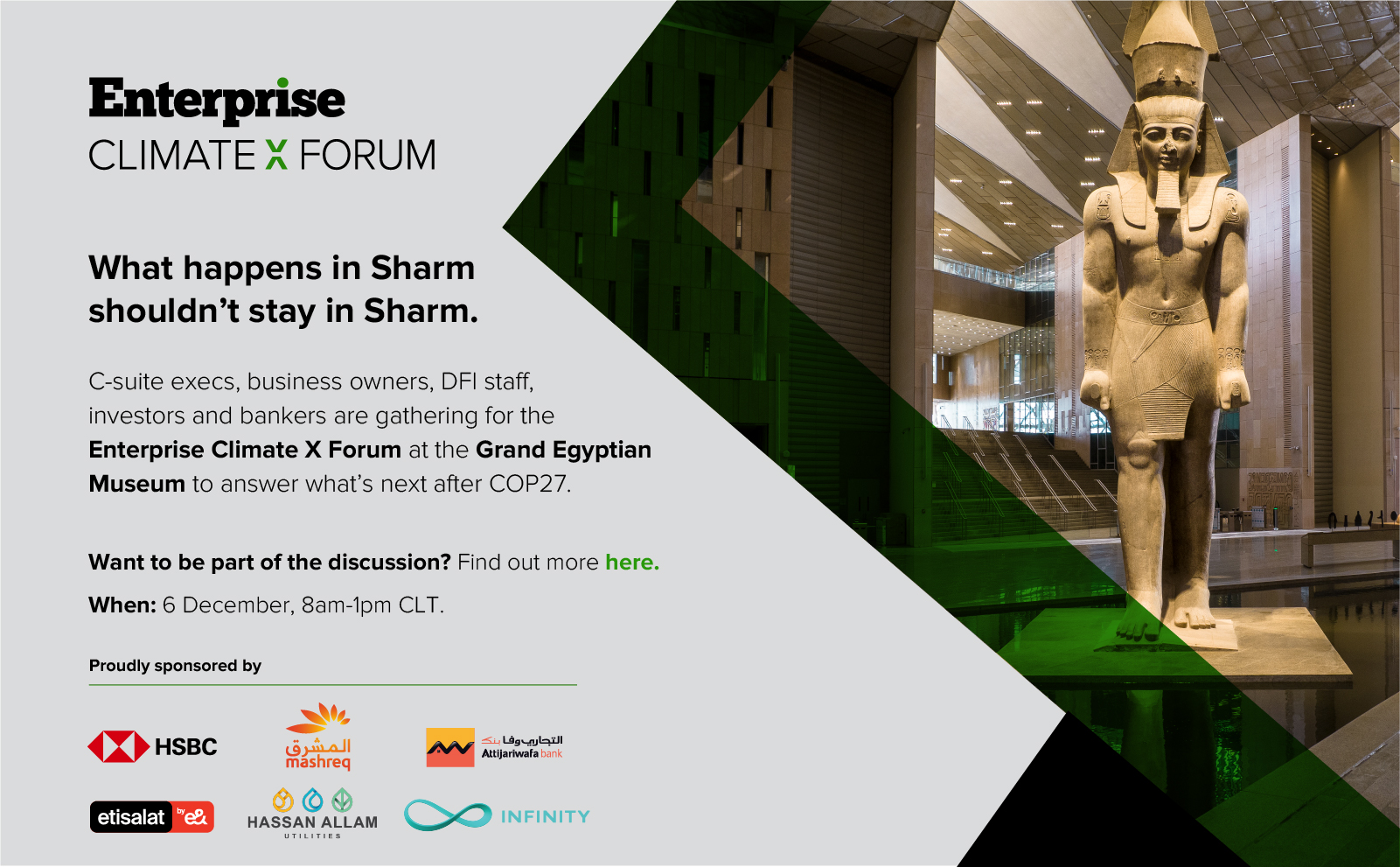- Model contracts for Egypt hydrogen plans to be ready by mid-2023 + thoughts on how you should view the H2 land grab. (Green Hydrogen)
- Qatar is promising to host the first carbon-neutral World Cup — was that ever possible? (Emissions)
- Lekela will invest USD 6 bn in Africa’s energy, with USD 2 bn going to Egypt. (Renewables)
- UAE’s Masdar Green REIT acquired green property assets worth AED 934 mn. (Green Construction)
- Construction starts on the second of four reactors at Egypt’s 4.8 GW Dabaa Nuclear Power Plant. (What We’re Tracking Today)
- US AeroFarms will build a vertical indoor farm in Qatar. (Also On Our Radar)
- Only 15 days to go before the Egyptian business community meets for the Enterprise Climate X Forum. (Circle Your Calendar)
- We’re saving endangered donkeys through IVF interbreeding. This should go well. (On Your Way Out)

Tuesday, 22 November 2022
Qatar is promising to host the first carbon-neutral World Cup, but was that ever possible?
TL;DR
WHAT WE’RE TRACKING TODAY
Good morning, friends — there’s no rest for the wicked as the post-COP news snooze we were expecting hoping for simply didn’t materialize. While much of the region is relatively quite this morning — with no word yet on whether Dubai Islamic Bank kicked off its green sukuk roadshow — COP27 host Egypt continued to deliver.
THE BIG CLIMATE STORY- More stragglers from COP27: Lekela announced that it will invest USD 2 bn in Egypt over the next four years as part of the company’s USD 6 bn plan to quadruple its energy production capacity in Africa to 4 GW by 2026.
We also know more on the timeline for the nine hydrogen agreements Egypt signed at COP27. The final model shareholder contract should be ready some time in 2Q2023, Planning Minister Hala El Said said; she suggests that means we could see Egypt unlock investments worth as much as USD 16.5 bn by 2025-26. We have details + thoughts on how we should all be thinking about the hydrogen land grab.
MISSED OUR ROUNDUP ON COP27? Read up on the climate finance agreements, major projects, and policy initiatives to come out of the summit here, here and here.
MEANWHILE- What’s the environmental cost to hosting the World Cup? Without trying to pile on the hate on what has been (from a football perspective) an excellent tournament so far, we breakdown the cost of emissions the USD 250 bn tournament is expected to rack up over the timeline of development and hosting the event.
^^ We have chapter and verse on these stories and more in the news well, below.
THE BIG CLIMATE STORY OUTSIDE THE REGION- The post-COP debrief continues in the international press: International climate coverage remains focused on COP27, with Bloomberg terming the summit’s loss and damage agreement as “flawed but historic” and zeroing in on the lack of progress on phasing out fossil fuels. Reuters offers a run-down of where COP27 progressed beyond previous COPs, with its greater focus on carbon trading, adaptation, and curbing agricultural emissions. The Financial Times looks at plans by recently-appointed UN climate chief Simon Stiell to give the COP process a shake-up and make it “as effective as possible.” And the Guardian cites warnings from climate experts and campaigners that large economies need to make “fresh commitments” to slash emissions.
The soundbite of the day goes to UN secretary general António Guterres: “Our planet is still in the emergency room. We need to drastically reduce emissions now — and this is an issue this COP did not address. The world still needs a giant leap on climate ambition.”
PROJECT MILESTONE- Construction has started on the second of four reactors at Egypt’s 4.8 GW Dabaa nuclear power plant, according to an Egyptian government statement on Saturday. Egypt and Rosatom began construction on the USD 30 bn plant in July of this year, kicking off an eight-year construction timeline. The facility is due to come online in the mid-2030s.
PSA- Amazon Web Services’ Clean Energy Accelerator 3.0 is accepting applications from mature startups working in breakthrough clean energy technologies. Challenge focus areas include carbon capture and storage, economic hydrogen generation and transport, grid modernization, energy storage and resilience. Selected companies will participate in a 12-week virtual and in-person training in Seattle in 2Q 2023 with mentorship from industry leaders from around the world. Program outcomes will be showcased during COP28 in Dubai next year. The submission window is open until January 1, 2023.
|
***
YOU’RE READING ENTERPRISE CLIMATE, the essential MENA publication for senior execs who care about the world’s most important industry. We’re out Monday through Thursday at 4am Cairo / 5am Riyadh / 6am UAE.
Were you forwarded this email? Get your own subscription without charge here or reach out to us on climate@enterprisemea.com with comments, suggestions and story tips.
***
HAPPENING TODAY-
Cityscape Intelligence Talks is taking place today and tomorrow at the Dubai World Trade Center. The event will focus on highlighting the construction industry’s climate resilience efforts. You can register for the event here.
CIRCLE YOUR CALENDAR-
COP27 may be over — but climate will remain the world’s largest and most important industry for decades to come. Our Enterprise Climate X Forum will see members of the business community gather at the Grand Egyptian Museum on Tuesday, 6 December 2022.
What’s the Enterprise Climate X Forum? It’s our first industry-specific conference, where CEOs, top execs, investors, bankers and development finance folks have the chance to talk about how to build a climate-centered business — and how to make sure your business continues to have access to the funds it needs to grow. You can learn more on our conference website here.
Some of the biggest names in business and finance are on board — are you? If you’re a C-suite exec, business owner, climate professional, DFI staff, investor or banker, please email us at climatexrsvp@enterprisemea.com to signal your interest, letting us know your name, title and where you work.
Saudi Arabia’s Education Ministry will host its Global Conference on Sustainable Partnerships next Wednesday, 23 November to Thursday, 24 November in Riyadh, bringing together ministers and senior officials from the private and public sectors.
UAE will host The Big 5 Global Construction Impact Summit on Wednesday, 7 December at the Dubai World Trade Centre, bringing more than 2k exhibitors from 60 countries, as well as regional and global construction industry leaders together to discuss ways to meet local and global net zero and waste reduction targets.
Check out our full calendar on the web for a comprehensive listing of upcoming news events, national holidays and news triggers.
GREEN HYDROGEN
Model contracts for Egypt hydrogen plans to be ready by mid-2023 + thoughts on how you should view the H2 land grab

Egypt has given us a first peek at the timeline for the rollout the nine hydrogen plants for which it signed framework agreements at COP27. According to Planning Minister Hala El Said, we can expect:
- Model shareholder agreements ready by 2Q 2023;
- Signed agreements sometime around mid-year.
Why this matters: Subtle changes in language in the model shareholder agreement could make or break the viability of a project. And it’s not just Egypt that’s competing for developer interest — you can think about what’s going on right now as a land grab. Ultimately, each project developer aims to have multiple projects lined up around the world and — with limited capacity at their companies and in the supply chain — will execute the one(s) that make the most economic sense. If would-be regional titans Egypt and Saudi Arabia are going to get this right, they need to move quickly — but carefully.
So when will Egypt see money being spent? It’s a long game. El Said’s remarks yesterday gave us insight into how Egypt sees the hydrogen boom being phased, suggesting she expects as much as 16.5 bn to be deployed by 2025-26, with the balance happening in three phases, one ending in 2030 (worth as much as USD 38 bn) and one in 2035 (USD 28.5 bn). The caveat there, of course, is that the numbers she was talking about assume 100% of the projects now on deck will make it past final investment decision and to implementation.
Egypt isn’t done building a pipeline of potential projects: A new framework agreement with two international companies could be expected signed “during the coming period,” El Said added, without disclosing details.
With a little help from our friends? Egypt and the World Bank are lining up cooperation agreements in green hydrogen and renewable energy, according to a statement by the Egyptian Electricity Ministry on Sunday.
REFRESHER- Egypt had signed nine framework agreements with international power companies to construct green hydrogen and ammonia facilities in the Suez Canal Economic Zone at COP27 last week and the facilities will collectively produce up to 7.6 mn tons of green ammonia and 2.7 mn tons of hydrogen a year when fully operational.
AND REMEMBER- All of this is very new, not just to Egypt, but in the global marketplace. Electrolyser technology still has at least a few years left to mature. Rising interest rates in USD will challenge project economics. There are no pipelines linking Egypt to Europe to sell hydrogen or “carrier molecules.” There’s finite capacity in the world to design and build plants, let alone to supply electrolysers. And by our math, we still don’t have enough green power generation capacity — let alone the green corridor it will need to be transmitted to from solar or wind farms to plants — to do all of the projects now on the drawing board.
So, Enterprise — you’re pessimistic? Not even a little bit. We think hydrogen definitely has a place in the world’s energy mix going forward — and as it does, there are few places as well-suited to produce it than Egypt. But there are lots and lots of issues to sort out as we build this fascinating industry.
MORE DETAIL ON GLOBELEQ’S PLANT-
UK power producer Globeleq will develop, finance, build, own and operate its green hydrogen project in Egypt’s Suez Canal Economic Zone as a lead investor and developer, according to a company statement. The 2 mn ton per annum project will be developed in three phases over the next 12 years. It will see a total of 3.6 GW of electrolyzers powered by up to 9 GW of solar and wind energy. Green fuel production will also be considered. The first phase will see the production of 100k tons of green ammonia from hydrogen for export to Europe and Asia by 2026/2027. The firm had inked the agreement at COP27, following an MoU in August.
EMISSIONS

It turns out it’s very hard to host a “green” World Cup: The tournament kicked off on Sunday and over 1 mn fans are expected to have visited the Gulf country in the coming month. However, the environmental cost and emissions generated by hosting the tournament — from exorbitant water usage to keep pitches green to construction and aviation emissions — has led critics to question claims of carbon-neutrality.
How much emissions are we talking about? For starters, a 2021 FIFA report estimated that 3.6 mn tons of carbon dioxide will be produced between 2011 and 2023 in association with the tournament — by comparison, Russia produced almost 2.2 mn tons of emissions during the last world cup, according FIFA’s 2018 report.
In fact, skeptics believe emissions will be much higher: A report by Carbon Market Watch claims that the tournament’s emissions will in fact be up to 8x higher than the organizers’ estimates, and that the new venues — seven of which were constructed from scratch — are the highest source of emissions. The country has also built roads, hotels and a metro system over the course of the past decade, reports PBS, with many critics contesting the environmental impact of these huge construction projects.
Spectators are flying in from their hotel rooms for games: The tournament organizers are running over 500 shuttle flights daily from neighboring cities including Dubai to address Doha’s accommodation shortage for fans, Reuters reports. 52% of tournament-related emissions are expected to come from air travel alone, FIFA’s report estimated.
And keeping the turf green is coming at a hefty cost: Maintaining one football turf has cost Qatar at least 10k liters of desalinated water daily for the past few months, Reuters reported earlier this year — a far cry from the 50k liters needed to maintain one of those stadium pitches in the country’s sweltering summer months. Qatar is home to eight stadiums and 136 training grounds, which groundskeepers have been blasting directly with chilled air since September to mimic winter temperatures in order to seed pitches with ryegrass in preparation for the tournament.
So how is Qatar planning to offset all these emissions? The host country is promising to reduce FIFA’s estimate through carbon savings from its 800 MWp Al Kharsaah solar power plant to offset half of the event’s emissions and the purchase of 1.8 mn tonnes of carbon credits from the Doha-based Global Carbon Council to offset the cup’s remaining emissions. “Delivering a carbon-neutral FIFA World Cup is a countrywide effort. We are proud of the vast number of projects implemented to help Qatar achieve this goal,” said Yasir Al Jamal, director general of Qatar’s Supreme Committee for Delivery & Legacy.
But the plan has drawn criticism: The Global Carbon Council approves projects in India, Turkey and Serbia who in the past incentivized developers to build renewables projects with the promise of additional revenue with carbon credits sale — but no longer need this incentive due to the steep drop in the cost of renewable power over the past decade, Bloomberg reports. As it stands, large renewable projects are generating credits that allow others to pump out new emissions and “issuing carbon credits to large renewable energy projects in 2022 goes against fundamental integrity rules of carbon markets,” policy lead at Carbon Market Watch Gilles Dufrasne tells Bloomberg.
RENEWABLES
Lekela looking to invest USD 2 bn in Egypt over the next four years, has bns more for Africa

Independent power producer Lekela will invest USD 2 bn in Egypt over the next four years, the company’s CEO Chris Antonopoulous told Bloomberg Asharq on the sidelines of COP27. This is part of the company’s USD 6 bn plan to quadruple its energy production capacity in Africa — with a focus on wind — to 4 GW by 2026. In Egypt, the company is looking to build wind farms west of the Nile as the Red Sea becomes saturated, he said.
Where else is the money going? Another USD 2 bn are earmarked for South Africa, while the rest will go to other African markets, he added.
And where will it come from? The company generally looks to finance some 25-40% of its projects through the sale of ownership stakes, he told Bloomberg, with the remainder coming from banks and long-term multilateral lenders like the European Bank for Reconstruction and Development (EBRD) and the International Finance Corporation (IFC).
Lekela’s new owners will increase its focus on the Middle East (and Egypt): The company was acquired by Egyptian renewables provider Infinity and Africa Finance Corporation last summer, making Infinity the continent’s largest renewables player. The acquisition is expected to close in January, Infinity co-founder and chairman Mohamed Mansour told Bloomberg. “With the acquisition, we will transform into a Middle Eastern company,” Antonopoulous added. The company currently does not have any projects in the Middle East, besides its 252 MW West Bakr wind farm in Egypt, according to its website.
And will widen its targeted sector pool: “We look forward to entering new sectors such as green water desalination and green hydrogen production, hopefully in partnership with the Sovereign Fund of Egypt,” Antonopoulos explained.
GREEN CONSTRUCTION
Masdar Green REIT acquires ‘green’ properties worth USD 254 mn

Masdar-backed real estate fund snaps up ‘green’ buildings: The UAE’s renewable giant’s Masdar Green real estate investment trust (REIT) acquired property assets worth AED 934 mn (USD 254 mn) in Abu Dhabi, according to a statement. The REIT secured USD 200 mn in green financing from First Abu Dhabi Bank to grow its portfolio earlier this year, Wam reported.
What is Masdar Green REIT? Owned by Abu Dhabi’s sovereign wealth fund Mubadala, Masdar Green REIT is the UAE’s first real estate trust to invest in sustainable assets only, with its portfolio centered in Abu Dhabi’s Masdar City. In 2018, Masdar received the MENA region’s first green revolving credit facility.
Masdar Green REIT is on a roll: Over the past couple of years, the trust has increased its assets twofold and is mulling over expanding its sustainable realty development across the GCC and MENA region. Its current portfolio value is AED 1.91 bn and with ‘further assets identified for potential future investments’.
What is so ‘green’ about these buildings? They are platinum and gold LEED certified — acknowledged industry standards for building system efficiency, sustainability, water efficiency, materials used for construction, and environmental quality. “The properties within the Masdar Green REIT’s current portfolio consume approximately 40% less electricity and water than comparable buildings in Abu Dhabi,” REIT chairman Abdulla Balalaa told Gulf Business earlier this year.
SOUND SMART- What does it mean to be LEED-certified? To be LEED-certified, a building’s construction and operations must emit a maximum of 0.009 tonnes of CO2 per square ft, according to performance measurement platform Arc, which is affiliated to the US Green Business Council that developed the LEED system and issues the certifications. Gold-certified buildings should see emissions capped at 0.006 tonnes per square ft, while Platinum LEED buildings shouldn’t emit more than 0.004 tonnes of CO2 per square ft.
ALSO ON OUR RADAR
US-based AeroFarms will build a vertical indoor farm in Qatar, according to a company statement. In partnership with the Qatar Freezones Authority and Doha Venture Capital, the firm will harness indoor agritech to grow produce using 95% less water than traditional farming with zero pesticides.
OTHER STORIES WORTH KNOWING ABOUT THIS MORNING-
- Egypt’s CIB is planning to establish a sustainable financing academy, according to a statement yesterday.
- Siemens will provide KSA’s Electromin with EV chargers to develop a national and regional charging network, Zawya reports.
- Iraq’s Kurdistan region completed a water treatment project to use sewage water for irrigation, Iraqi News reported last week.
ON YOUR WAY OUT

Preserving endangered species through test tube babies: Scientists at the University of Queensland believe the successfully developed embryo of an endangered European donkey opens up avenues for saving other endangered species, EuroNews reports. Researchers say a new in vitro fertilization (IVF) process known as intracytoplasmic sperm injection can create viable embryos, allowing production of embryos in a laboratory and opening a world of possibilities for repopulating species if needed. In a nutshell, they’re interbreeding closely related species through IVF. If Michael Crichton (or Jeff Goldblum) are anything to go by, this should end well.
Speaking of donkeys… did you know that 20 breeds are endangered? Donkey populations in Europe and wild donkeys worldwide are at risk of illegal slaughtering and decreased grazing land, a scientist on the project tells EuroNews.
CALENDAR
NOVEMBER
21-23 November (Monday-Wednesday): Cityscape Intelligence Talks, Dubai World Trade Center, UAE.
23-24 November (Wednesday-Thursday): Global Conference on Sustainable Partnerships, The Ritz-Carlton, Riyadh, Saudi Arabia.
Deadline of bid submissions for the Ras Mohaisen – Baha – Makkah Independent Water Transmission Pipeline in Saudi Arabia.
DECEMBER
6 December (Tuesday): Enterprise Climate X Forum, Cairo, Egypt.
7 December (Wednesday): The Big 5 Global Construction Impact Summit, Dubai World Trade Center, Dubai, UAE.
13-14 December (Tuesday-Wednesday): Seminar on EU standards for agri-food products for the Gulf Cooperation Council countries, Grand Millennium Business Bay Hotel, Dubai, UAE.
13-15 December (Tuesday-Thursday): International Renewable Energy Congress, Hammamet, Tunisia.
15 December (Thursday): The UN’s 15th meeting of the Conference of the Parties to the Convention on Biological Diversity (COP15), Montreal, Canada.
JANUARY 2023
10-12 January (Tuesday-Thursday): The Future Minerals Forum, Riyadh, Saudi Arabia.
13 January (Friday): The International Renewable Energy Agency’s Youth Forum, Abu Dhabi, UAE.
14-21 January (Saturday-Saturday): Abu Dhabi Sustainability Week, Abu Dhabi, UAE.
16-18 January (Monday-Wednesday): EcoWASTE, Abu Dhabi National Exhibition Center (ADNEC), UAE.
16-18 January (Monday-Wednesday): World Future Energy Summit, Abu Dhabi National Exhibition Center (ADNEC), UAE.
January 2023: Bid submission deadline for green hydrogen projects to Hydrogen Oman (Hydrom).
FEBRUARY 2023
6-8 February (Monday-Wednesday): Saudi International Marine Exhibition and Conference, Hilton Riyadh, Saudi Arabia.
21-22 February (Tuesday-Wednesday): The Arab Green Summit, Dubai, UAE.
21-23 February (Tuesday-Thursday): World Environment, Social and Governance (ESG) Summit, Dubai, UAE.
MARCH 2023
15-19 March (Wednesday-Sunday): Qatar International Agricultural and Environmental Exhibition, Doha, Qatar.
MAY 2023
1-4 May (Monday-Thursday): Arabian Travel Market, Dubai World Trade Centre, Dubai, UAE. Register here.
29-31 May (Monday-Wednesday): Electric Vehicle Innovation Summit, Abu Dhabi National Exhibition Centre, Abu Dhabi, UAE.
JUNE 2023
Bloomberg New Economy Gateway Africa Conference, Marrakesh, Morocco.
1-3 June (Thursday-Saturday): Envirotec and Energie Expo, UTICA, Tunis, Tunisia.
SEPTEMBER 2023
Chariot Limited and Total Eren’s feasibility study on a 10 GW green hydrogen plant in Mauritania to be completed.
OCTOBER 2023
2-4 October (Monday-Wednesday): WETEX and Dubai Solar Show, Dubai World Trade Centre, Dubai, United Arab Emirates.
NOVEMBER 2023
6-17 November (Monday-Friday): The UAE will host COP28.
EVENTS WITH NO SET DATE
End-2022
KSA’s Neom wants to tender three concrete water reservoir projects to up its water storage capacity by 6 mn liters.
2023
Early 2023: Egypt’s KarmSolar to launch KarmCharge, the company’s EV charging venture.
1Q2023: Oman will award two blocks of land for green hydrogen projects in Duqm, Oman.
Mid-2023: Sale of Sembcorp Energy India Limited to consortium of Omani investors to close.
Phase C of the 900-MW of the Mohammed bin Rashid Al Maktoum Solar Park in Dubai to be completed.
Saudi Basic Industries Corporation (Sabic) steam cracker furnace powered by renewable energy to come online.
4Q2023: Oman to award four blocks of land for green hydrogen projects in Thumrait, Oman.
2024
End-2024: Emirati Masdar’s 500 MW wind farm in Uzbekistan to begin commercial operations.
QatarEnergy’s industrial cities solar power project will start electricity production.
First 1.5 GW phase of Morocco’s Xlinks solar and wind energy project to be operational.
2025
Second 1.5 GW phase of Morocco’s Xlinks solar and wind energy project to be operational.
UAE to have over 1k EV charging stations installed.
2026
1Q 2026: QatarEnergy’s USD 1 bn blue ammonia plant to be completed.
End-2026: HSBC Bahrain to eliminate single-use PVC plastic cards.
Iraq’s Mass Group Holding wants to invest EUR 1 bn on its thermal plant Mintia in Romania to have 62% of run on renewable energy, while expanding its energy capacity to at least 1.29k MWh.
2027
MENA’s district cooling market is expected to reach USD 15 bn.
2030
UAE’s Abu Dhabi Commercial Bank (ADCB) wants to provide AED 35 bn in green financing.
UAE targets 14 GW in clean energy capacity.
Tunisia targets 30% of renewables in its energy mix.
Qatar wants to generate USD 17 bn from its circular economy, creating 9k-19k jobs.
Morocco’s Xlinks solar and wind energy project to generate 10.5 GW of energy.
2035
Qatar to capture up to 11 mn tons of CO2 annually.
2045
Qatar’s Public Works Authority’s (Ashghal) USD 1.5 bn sewage treatment facility to reach 600k cm/d capacity.
2060
Nigeria aims to achieve its net-zero emissions target.
Enterprise Climate is available without charge thanks to the generous support of HSBC (tax ID: 204-901-715), the leading corporate and retail lender in Egypt; and Infinity Power (tax ID: 305-170-682), the leading generator and distributor of renewable energy in Africa and the Middle East. Enterprise Climate is delivered Mon-Thurs before 4 am UAE time. Were you forwarded this copy? Sign up for your own delivery at climate.enterprise.press. Contact us on climate@enterprisemea.com.


